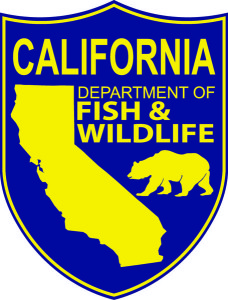California Department of Fish and Wildlife (CDFW)
From CCoWS Wiki
Need a page for California Department of Fish and Wildlife

California Department of Fish and Wildlife logo [1]
History in California
California Department of Fish and Wildlife (CDFW) has a long history in California. Conservation laws pertaining to fish and wildlife predate the establishment of the CDFW, which began originally as the Board of Fish Commissioners in 1870. [1]
- Pre 1851- Spanish and Mexican game and fish laws applied
- 1850s- California's first official fish and game laws established to protect species such as: oysters elk, deer, salmon, and quail. Game laws are extended to all counties in California
- 1860s- First closed seasons for trout fishing established
- 1870s- Board of Fish commissioners is established, two of the first full-time game wardens are appointed, and the Fish commission authority is expanded to include game
- 1885- First California fish and game laws published
- 1901- Authority is expanded and game bag limits are set
- 1909- Name changed to Fish and Game Commission following a greater emphasis placed on game laws
- 1913- First year fishing licenses are required. New Law prevents the taking of sea otters
- 1920s- Reorganization of the Commission creates 3 new departments: fish culture, commercial fisheries, and patrol. Duties of the Fish and Game Commission taken over by the Division of Fish and Game (DFG)
- 1945- A Constitutional amendment gives the Commission authority to make regulations for sport fishing and hunting
- 1950s- Five regional offices established. New branches include: Bureaus of Game, Conservation, Inland Fisheries, Patrol, and Marine Research. The Fish and Wildlife Coordination Act is enacted requiring consideration of DFG resources by state agencies when planning federal projects. Creation of The Water Projects Branch to monitor impacts of land use and water development projects on water quality.
- 1960s- DFG becomes part of the Resources of California agency. The Davis-Dolwig act enables DFG to be more influential to the State Water Project planning. A DFG water quality laboratory approved by legislature to work on projects affecting fish and wildlife. Anadromous fish Hatchery established.
- 1970s- the Endangered Species Act requires DFG to inventory the states threatened or endangered species. Multiple species populations are inventoried including sea otters and mountain lions. Drought in the late 70s require DFG to rescue and relocate threatened fish species. DFG releases new deer management limits in response to state legislation enacted to manage deer herds.
- 1980s- Caltip is created to enable citizens to report illegal taking of fish and game. DFGs wildlife education program begins to be taught in schools. An automated commercial fish tax system is started to monitor compliance. A randomized hunting tag system is started to divide up game tags distributed per year.
- 1990s- Aquaculture industry in California is placed first world-wide. First time a domesticated white sturgeon is spawned(federally listed). DFG becomes involved with oil spill response and prevention. Captive bred condors are released. DFG teams up with timber companies to restore fisheries and watershed resources. After the legislature passes the Marine Live Management Act, the DFG is required to set new commercial fishing regulations.
References
Links
Disclaimer
This page may contain student work completed as part of assigned coursework. It may not be accurate. It does not necessary reflect the opinion or policy of CSUMB, its staff, or students.